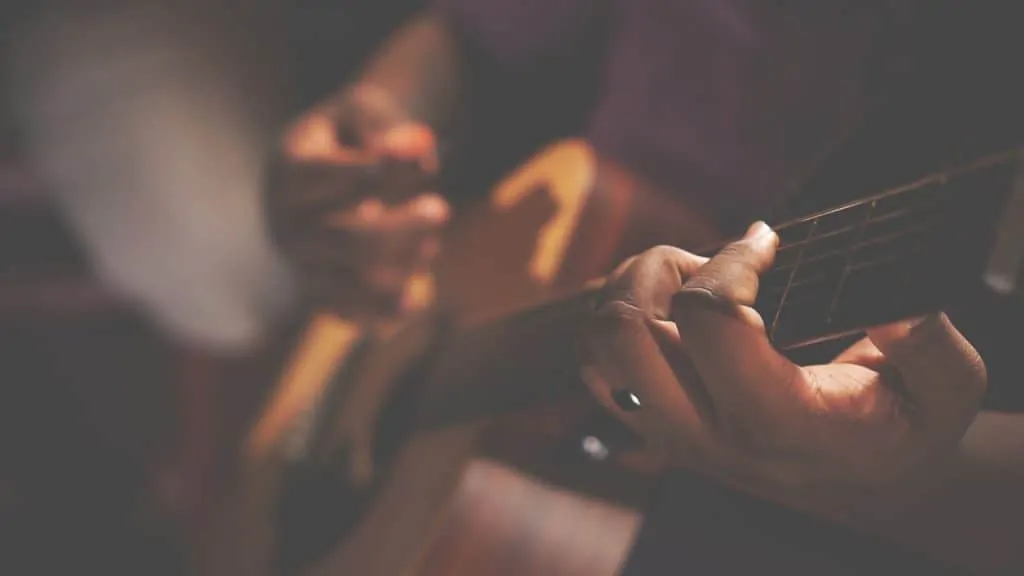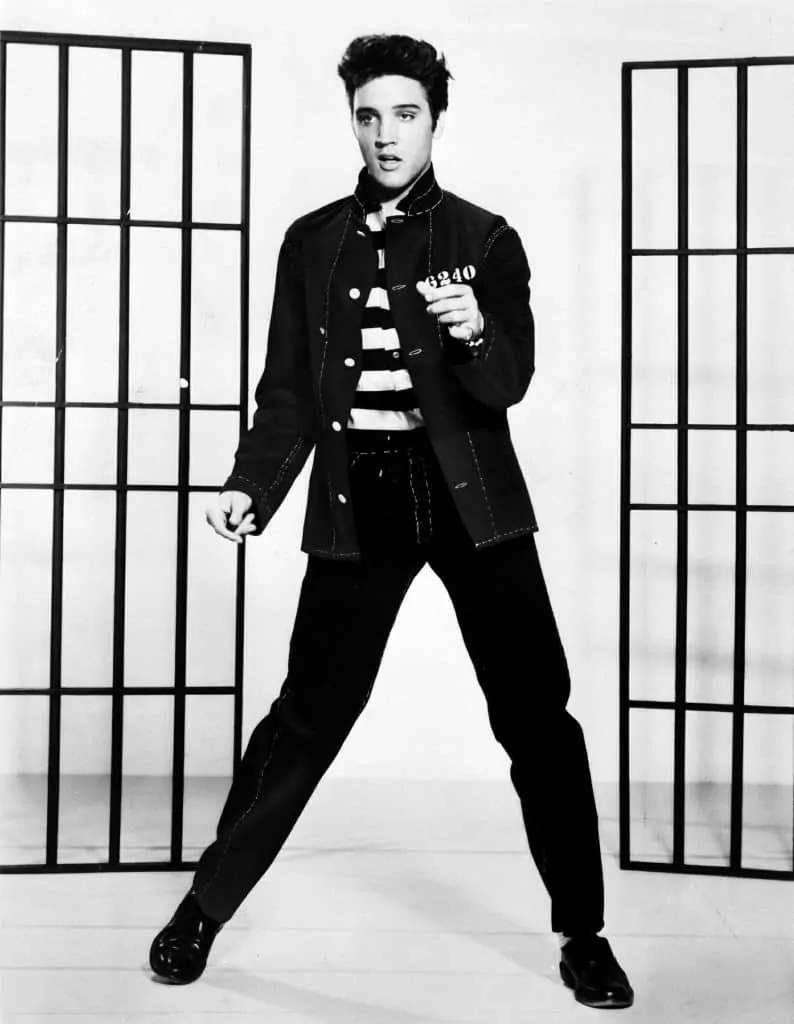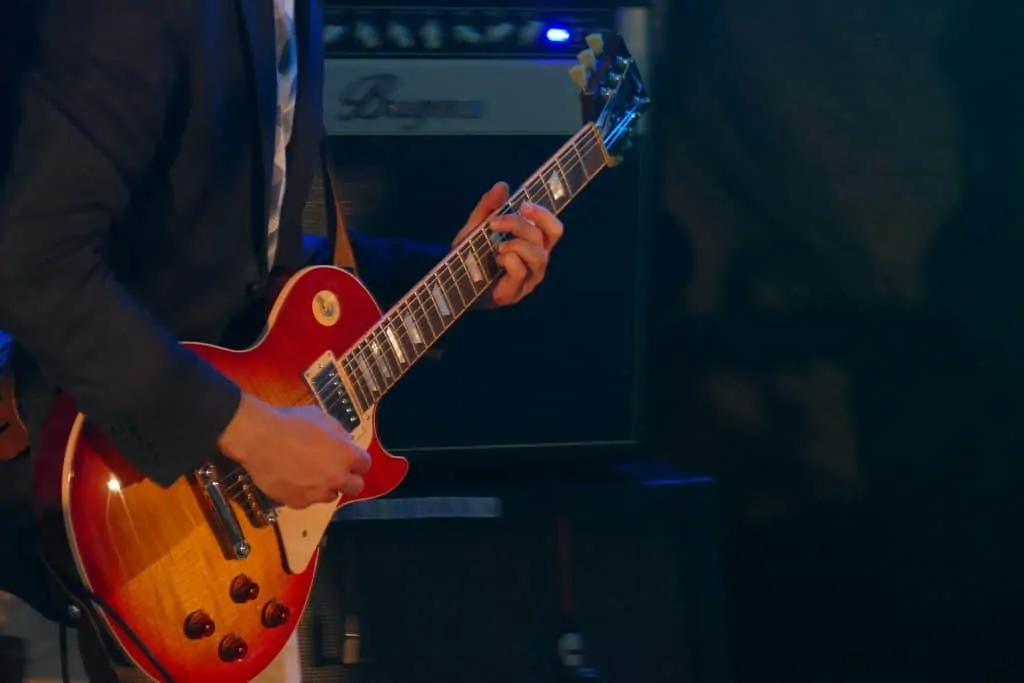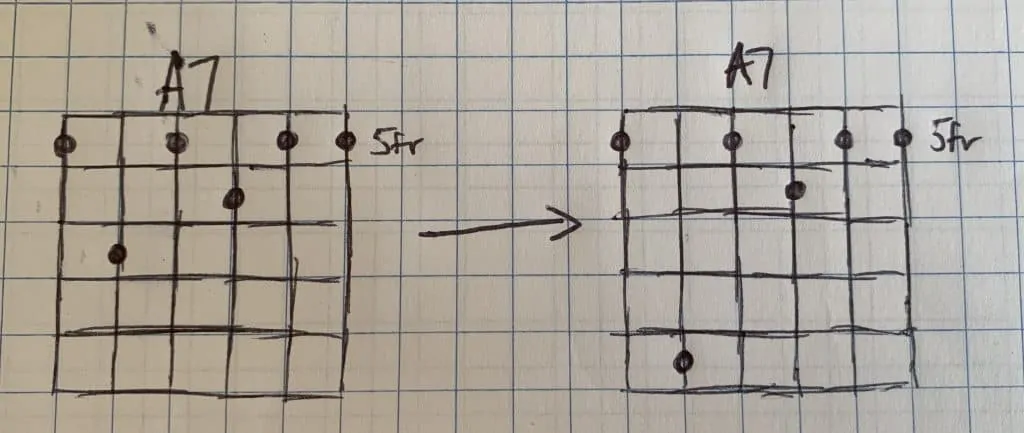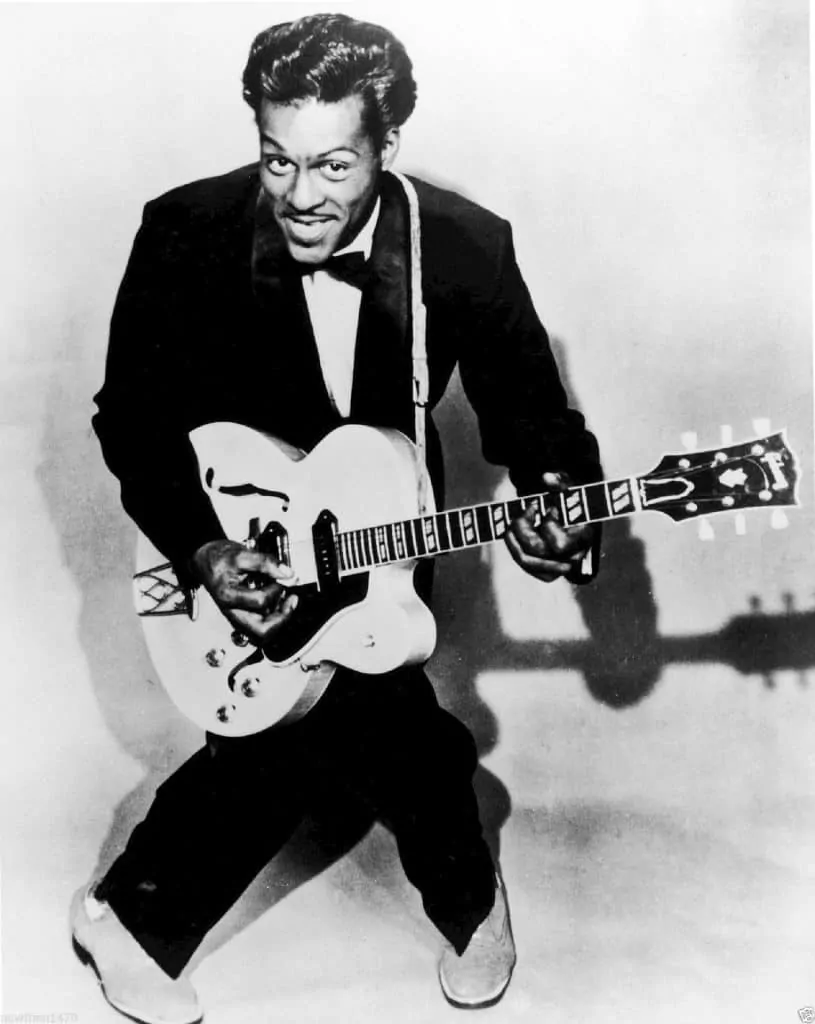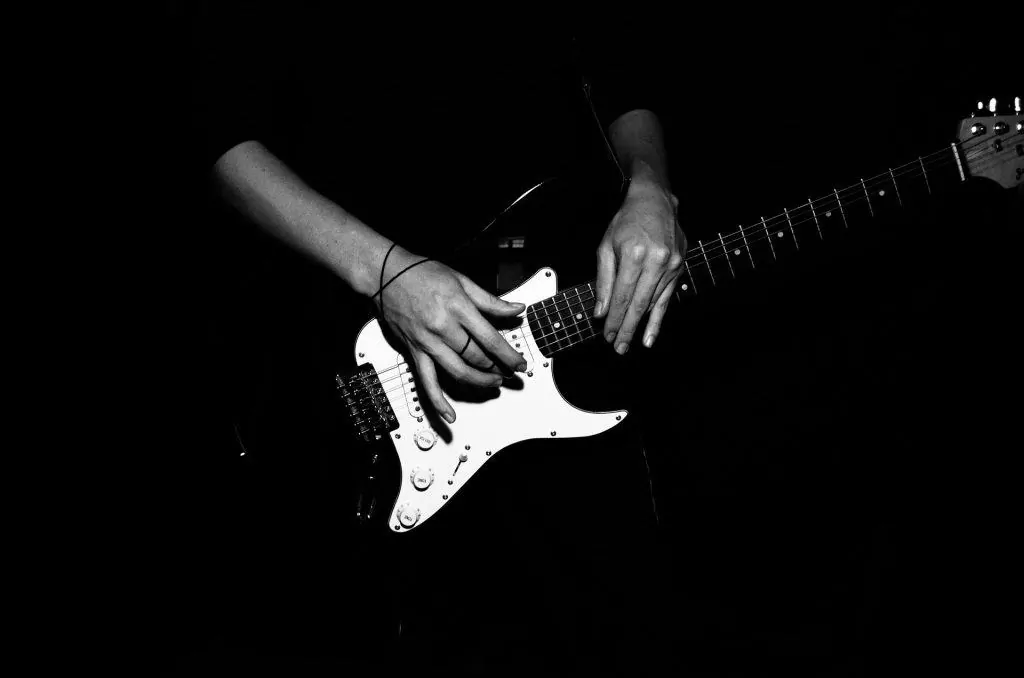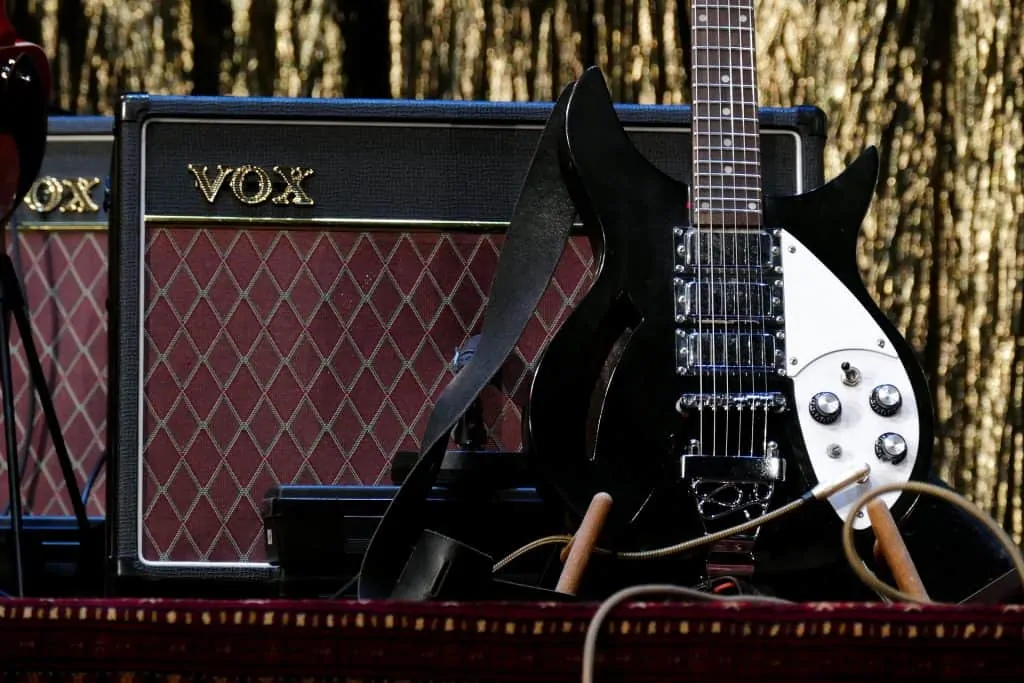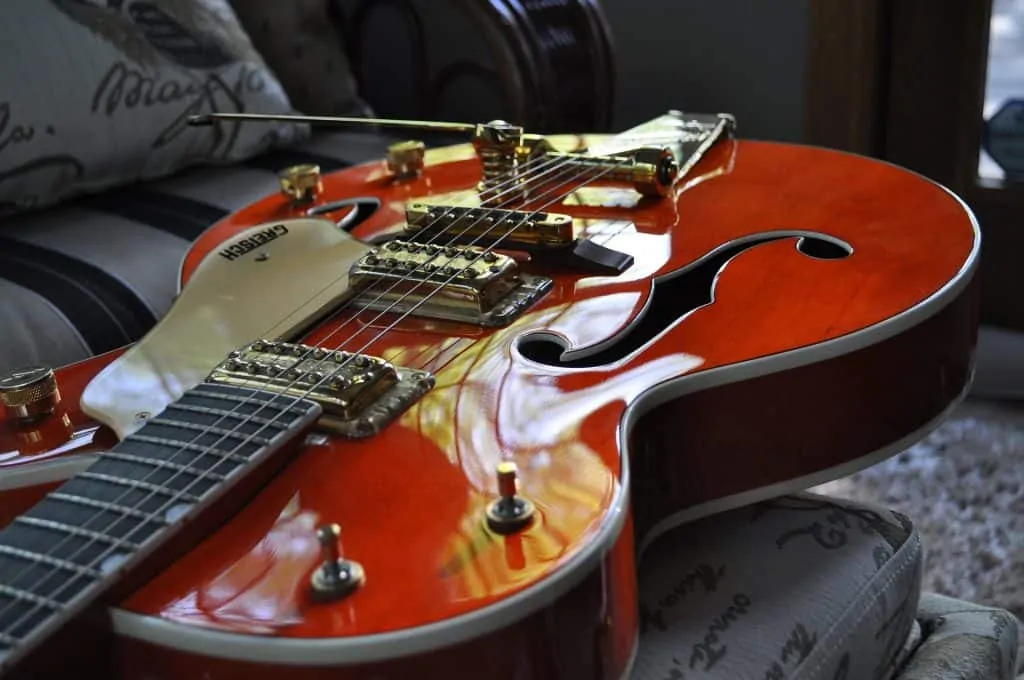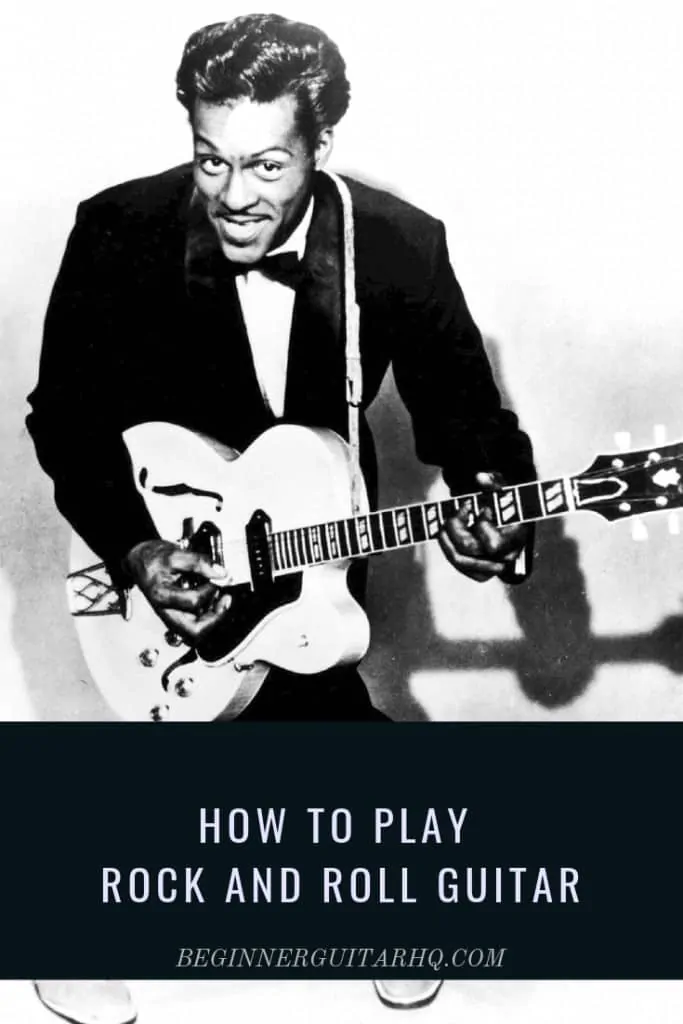One of the first iterations of rock music, rock and roll arose as the music of the baby boomer generation in the early 1950s through the early 960s. Based predominantly on a sped-up blues format and cataloguing the daily lives of teenagers and youth, rock and roll quickly rose to become one of the most popular music styles among young people and laid the foundation for the eventual success of countless classic bands.
Playing rock and roll guitar can be intuitive but requires skill and knowledge to master. When done right, it can certainly be one of the most exhilarating styles of music around.
Rock and roll guitar’s roots can be traced back to acoustic blues and country players.
Contents
Characteristics of Rock and Roll Guitar
Rock and roll evolved primarily from the electrified blues movements of the 1940s and early 1950s. Itself based on the Mississippi Delta blues tradition, electric blues amplified the 12-bar format and pentatonic soloing style for larger audiences.
As those audiences continued to grow and blues players continued to improve their soloing chops, some performers sped up blues songs to a more peppy, danceable beat. This music style, termed “rhythm and blues,” carried many of the elements eventually found in rock and roll.
Yet while rhythm and blues music may have been the primary influence in the development of rock and roll, other forms like country and swing played a roll as well. The danceable nature of these genres and their boogie lines carried into later rock and roll.
Early rock and roll artists like Chuck Berry and Little Richard borrowed much of their instrumentation and feel from electric blues, but added a new direction with their expressive solos (Berry on guitar, Little Richard on piano) and new lyrical style: rather than the downtrodden, forlorn blues singer, rock and roll vocalists sang about cars, love, and teenage life and incorporated more advanced wordplay into their lyrics.
Rock and roll guitar is characterized by a warm, slightly distorted guitar sound, especially from tube amplifiers. The chord vocabulary is generally based around the 12-bar blues (using the I, IV, and V chords), with heavy emphasis on traditional barre chords.
Most rock and roll players create a chugging, pusing rhythm by alternating between playing the fifth and sixth note of each barre chord in time as they strum. While it takes some practice to get used to, especially for players with smaller hands, this rhythm playing is one of the defining features of rock and roll.
Beyond earlier blues and jazz music, rock and roll was also one of the first genres to feature fast, danceable guitar solos. Lead guitar skill quickly became a calling card for young artists looking to prove themselves in rock, and was a critical skill for many different players on the scene. The importance placed on the electric guitar solo led to some of the first debates over the “best” guitarist around — debates that were generally settled on the basis of soloing skill.
Singer and guitarist Elvis Presley became the face of the early rock and roll movement.
Famous Rock and Roll Guitar Players
Chuck Berry may not have been the very first guitarist to play rock and roll, but he was without a doubt among the most charismatic and the most influential to boot. Berry’s blues-inspired solos, filled with unique bending and sliding techniques, practically created the lexicon for lead playing from rock and roll through classic and modern rock.
Berry’s 1955 smash “Maybellene” broke open the era of the electric guitar in rock and roll. Artists like Eddie Cochran followed Berry’s lead with hits such as “Twenty Flight Rock.” Following the pattern of a 12-bar blues, “Twenty Flight Rock” was notable for its teenage-focused lyrics and uptempo, danceable swing beat.
Breaking onto the music scene with his debut record in 1957, Buddy Holly was another major influence in the development of rock and roll guitar music. Unlike Berry and Cochran, Holly often penned songs outside of a 12-bar blues format — his biggest hits, “That’ll Be The Day” and “Peggy Sue,” both use chords outside of the traditional blues structure — and became noted for his exceptional guitar skills as well as his distinctive appearance (complete with thick-rimmed glasses).
At the same time as artists reinvented blues music for a rock and roll audience, rockabilly music — a fusion of traditional country songs with a rock and roll beat — was growing in popularity. Elvis Presley (with his electric guitarist Scotty Moore) and Carl Perkins are among the most famous guitar players of the genre, which was centered around Sam Phillips’ Sun Studios in Memphis, Tennessee.
Rockabilly recordings like Elvis’ “That’s All Right, Mama” and Carl Perkins’ “Blue Suede Shoes” (later covered by Elvis as well) were big hits in their own right, but they became even more important in rock and roll history because of their influence on a growing generation of young British rockers — a generation that would include The Beatles.
Rock and roll music spread to England in the mid to late 1950s, just as the guitar began to rise in popularity. By the early 1960s, players like John Lennon and George Harrison (as part of the Beatles) had made the leap to the United States in what would later be termed the British Invasion.
Though rock and roll soon evolved into a variety of new and different genres after the Invasion, British guitarists repopularized American rock and roll songs with their inventive and energetic covers, and bright, peppy guitar style. Thanks to the legacies of so many British Invasion bands like The Beatles, The Yardbirds, The Kinks, and The Rolling Stones, rock and roll music remains an enduring piece of American culture today.
Rock and roll uses lots of blues chord structures, revolving around the I, IV, and V chords.
Chords and Melody
Thanks to its heritage in blues and country, the vast majority of rock and roll songs use just three chords: the I, IV, and V. These are all major chords and can be played in different voicings all across the neck depending on the key and position.
The above diagrams show some common positions for playing different rock and roll chord voicings in different keys. Most rock and roll songs emphasize traditional barre chords; it’s easy to play all three chords in a I-IV-V progression within two frets of each other using solely “E” and “A” shape barre chords.
Rock and roll players also love to use dominant seventh chords for a more harmonically interesting rhythm part. Where major chords can sound very resolved and vanilla, dominant seventh chords offer more tension and inject new flavor into a common structure.
Dominant seventh chords are easy to play as barre chords and free up your pinky finger for some additional rhythm playing. Most rock and roll guitarists use their pinky finger to add the sixth note to each chord they play — take a look at the diagram below for examples.
Diagram showing how to add the sixth note to a dominant seventh chord. Most rock and roll guitarists keep their third finger planted on the fifth note and simply add their pinky to the sixth.
Alternating between playing the fifth and sixth note creates a driving, steady rhythm unlike any other found in blues or country. Knowing how to play those chords properly is essential for any rock and roll guitarist.
Rock and roll melodies tend to be very pentatonic, with blues inflections in the vocals. Guitarists often play the vocal melody through instrumental breaks; copying those vocal blues inflections with chromatic passing notes and blue notes is another important technique.
Holding down a rock and roll rhythm requires an ability to stretch between the fifth and sixth notes.
Rhythm
Rock and roll is dominated by one simple rhythm: the pulsating, alternating rhythm of barre chords with the added fifth and sixth. But though it may be simple, this pattern can be excruciating to play — just ask the many beginners who either haven’t practiced their barre chords yet or simply have hands too small to reach the four-fret stretch on the lower strings.
Most rock and roll artists alternate between the two in a shuffle pattern, playing the fifth twice than the sixth twice. Depending on the style of the song, it may be played either straight or swung, though swinging the rhythm is more common for shuffles.
Beyond that fifth and sixth shuffle pattern, there are a few other key rhythms to learn if you want to play rock and roll guitar. Most revolve around the I-IV-V chords used in a 12-bar blues, and are fairly simple to pick up once you’re comfortable with the chord shapes.
One common example is the lilting, offbeat swing found in the verses of Eddie Cochran’s “Twenty Flight Rock.” Playing three notes across each measure (all taken from the chords in a 12-bar blues pattern), this rhythm is more commonly used in the rockabilly subgenre and works well for providing a more rocked-up country feel than the standard blues shuffle.
Another vintage rock and roll song performed most notably by the Beatles, “Kansas City” offers a driving, chunky rhythm part that works well over plenty of different rock and roll songs. Based once again off the 12-bar blues chords, this rhythm incorporates muted strums with an ascending and descending guitar line for a percussive, swinging feel. Take a listen to the track below; pay extra attention to the way the guitar rhythm shifts over each chord in the 12-bar progression.
Finally, the famous “Bo Diddley” beat is an iconic rock and roll rhythm. Originally devised by namesake Bo Diddley, the beat divides a measure of 4/4 into five syncopated pulses, which can be either swung (in what is effectively a 3/2 clave rhythm) or played straight. Variations of this pattern can be found even outside of rock and roll music — the beat is a staple in songs from George Michael’s “Faith” to The Smiths’ “How Soon Is Now?”
Guitarist Chuck Berry created much of rock and roll’s soloing vocabulary with his unique sped-up blues style.
Solos
Rock and roll improvised solos borrow heavily from electrified blues and country — the vast majority of rock and roll guitarists operate within the pentatonic scale for their solos or simply outline the chords they’re playing. With that being said, the actual vocabulary of rock and roll lead guitar is distinct from the slower, more expressive blues and more chord-focused country styles.
Though rock and roll ises bending in solos, a technique traditionally associated with blues guitar, the function and technique are much different in each of the two genres. Blues guitarists often used wide, expressive bends to add extra emotion to slower, more melancholic solos. These bends were often accompanied by vibrato to mimic a more human voice on the guitar.
In contrast, rock and roll artists incorporated much faster, snappier bends into their playing as part of larger licks. Rock and roll bends are generally paired in tandem with other notes within a larger sequence.
Take a look at this example of a traditional rock and roll guitar lick, most famously used by Chuck Berry. The repeated bending sequence is one of the most recognizable parts in the introduction to his hit “Johnny B. Goode,” and became one of Berry’s trademark techniques throughout his career. Listen to that introduction below, and make sure to notice how Berry syncopates the bends over a standard 4/4 measure.
While it’s difficult for many beginner guitarists to repeatedly bend notes in tune at such speed, the offbeat rhythm and pentatonic emphasis are solo techniques any rock and roll player needs to master.
For an example of a rockabilly solo, check out George Harrison’s solo over “That’s All Right, Mama” in a group concert with Carl Perkins, Eric Clapton, and Ringo Starr. While rockabilly solos generally incorporate some single lines like faster rock and roll, they focus more on chords and double-stop licks (when a guitarists plays two notes at once, oftentimes with a muted string or more between).
To solo over rockabilly songs, you just need to know the basic chords and rhythm and have a good awareness of the pentatonic scale. Develop your double-stop techniques, and make sure to pay attention to the feel and pulse of each song. Restating the vocal melody is another common technique in rockabilly soloing; it’s a great tool to use if you’re looking for a simple, easy way to solo over new songs.
The Fender Stratocaster, released in 1954, is one of the most popular guitars for playing rock and roll.
Classic Rock and Roll Guitar Models
Rock and roll came onto the music scene at a time of great innovation: Leo Fender began to release the Telecaster and Stratocaster in the early 1950s, while Gibson would create their semi-hollow ES-335 model in 1958.
These new electric models quickly became favorites of rockers everywhere thanks to their sizzling tones and ability to play at loud volumes without feeding back. To this day, many of those guitars are still enduring classics.
It’s hard to beat a Fender Stratocaster for rock and roll playing.
The favorite of Buddy Holly, Stratocasters are known for their distinctive clean, quacking tone and three single-coil pickups. Fender Telecasters are another great option, though with two single-coils instead of three.
Teles are prized for their cutting, bright bridge pickup, especially for faster and more aggressive rock and roll styles.
However, Chuck Berry — the king of rock and roll music — preferred his iconic Gibson ES-350T and ES-335 guitars to any Fender models. The humbuckers on the 335 in particular lend a thicker, beefier tone and often create a warm, harmonic-filled sound when paired with vintage tube amps. If you’ve got the budget, the sound and semi-hollow style make an ES-335 a great choice for a rock and roll guitar.
Players looking to emulate rockabilly and the famous “Nashville Sound” may also enjoy the sparkling cleans of Gretsch guitars. Used most famously by rock and roll pioneer Eddie Cochran and Beatles legend George Harrison, Gretsch guitars offer their own distinctive chiming sound that’s hard to describe but easy to recognize.
Along with Gretsch, another American company played a critical role in the development of American rock and roll across the other side of the pond. That company was Rickenbacker. Thanks to tight import restrictions, many guitars manufactured in the United States were simply inaccessible to British rockers. However, some players — like George Harrison and John Lennon, respectively — managed to snag American-made Gretsch and Rickenbacker models.
In contrast with the warmer, fuller sound created by Gibson guitars and the balanced, versatile tones offered by Fenders, the bright, treble-boosted sound created by Gretsches and Rickenbackers became the defining guitar voice of the British Invasion. If you enjoy playing early 1960s British Invasion songs or simply like the clean and top-heavy tone, Ricenbackers and Gretsches are great options for you.
The combo of a Rickenbacker guitar and Vox amp was especially popular with early British rock and rollers.
Tones and Effects
Early rock and rollers used whatever amps they had available — rock and roll came of age before the consolidation of the guitar industry into a few major players. Many of the companies manufacturing amps for rock and roll music no longer exist (like Selmer) or no longer manufacture amps (like Gibson).
Because rock and roll music also arose before solid-state and digital amp technology developed, guitar players exclusively used tube amps. Today, these amplifiers are more expensive than other models because of their vintage tones and association with so many famous players from the rock and roll era. It’s possible to achieve a good approximation of rock and roll tones with modern amps — but if you want the real thing, a tube amp is the best way to get it.
Out of the many companies producing guitar amps in the 1950s, one name stands out: Fender. The California company manufactured a slew of different models for early rock and rollers; their line of tweed amps from the 1950s are among the most expensive vintage amplifiers in existence.
Players like Chuck Berry and Buddy Holly used Fender amplifiers almost exclusively throughout their careers, especially the legendary Bassman. While Bassmans, Bandmasters, Champions, and other tweed models are prohibitively expensive for players today, it’s easy to achieve many of the same warm clean tones with Fender’s modern reissues — the Blues Deluxe reissue and Blues Junior series are fantastic amps for this purpose.
Rock and roll also predated the use of modern stompbox effects; all the different sounds heard on rock and roll recordings were achieved in more old-fashioned ways. While the reverb so many players loved can be found on most tube amps, delay is a different issue.
Back in the day, recording studios featured massive rooms called echo chambers that could be used to create different effects. By piping a recording into the chamber and recording the result via a series of microphones in the room, artists could add a natural, luscious echo sound to their recordings. As technology progressed, many artists began using tape machines to mimic the echo provided by a full-size chamber. Tape echo is the source of that signature “slapback” delay found on so many Sun Records rockabilly recordings and vintage rock and roll songs.
If you’re looking to capture a warm tape echo sound today, you’ll need to use a pedal. Most delay pedals will be able to create a slapback sound, but units like the Catalinbread Belle Epoch, Strymon Deco, and Boss DM-2W stand out from the rest.
Gretsch hollow-body guitars like this one are great for rock and roll, especially rockabilly.
Summary
Over sixty years since its inception, rock and roll music continues to be a vibrant, exciting style of guitar playing and a dominant influence in American music today. Learning rock and roll guitar is a great way for any player to jump into rhythm and solo playing in a fun, accessible genre.
When you play rock and roll, remember to keep the groove chugging along and stay grounded in the pentatonic scale for your lead and solo lines. As always, listening to lots of rock and roll music is the best way to improve your skills!
